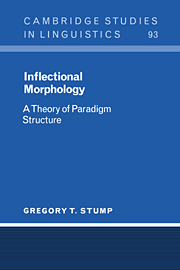5 - Rule blocks
Published online by Cambridge University Press: 14 October 2009
Summary
Introduction
In chapter 4, I argued that the postulation of paradigm functions is necessitated by two fundamental generalizations about the inflection of headed expressions, namely the Coderivative Uniformity Generalization and the Paradigm Uniformity Generalization; in particular, I demonstrated that the HAP – a principle for the evaluation of paradigm functions applying to headed roots – affords a better account of both generalizations than the Head Operation Hypothesis does. In this chapter, I present a second, independent argument for the postulation of paradigm functions; as I show, paradigm functions make it possible to provide a satisfactory account of the full range of observable interactions among realization-rule blocks in the world's languages.
This chapter also presents independent motivation for the postulation of rules of referral. In the Bulgarian analysis developed in chapter 2, a rule of referral was proposed to account for an instance of systematic syncretism in Bulgarian verb inflection; indeed, syncretism is the single phenomenon for which Zwicky (1985a) originally proposed the introduction of rules of referral into morphological theory. In this chapter, however, I argue that the introduction of this rule type is additionally motivated by phenomena having nothing to do with syncretism in the strict sense.
The fundamental question at issue in this chapter is: How are a language's blocks of realization rules organized? Anderson (1992) pursues the Fixed Linear Oordering Hypothesis (FLOH) in (I):
(I) Fixed Linear Ordering Hypothesis: A language's blocks of realization rules are arranged in a fixed linear sequence reflected by the sequence in which the rules themselves apply.
This hypothesis is consistent with the analysis of Bulgarian verb morphology developed in chapter 2.
- Type
- Chapter
- Information
- Inflectional MorphologyA Theory of Paradigm Structure, pp. 138 - 168Publisher: Cambridge University PressPrint publication year: 2001



